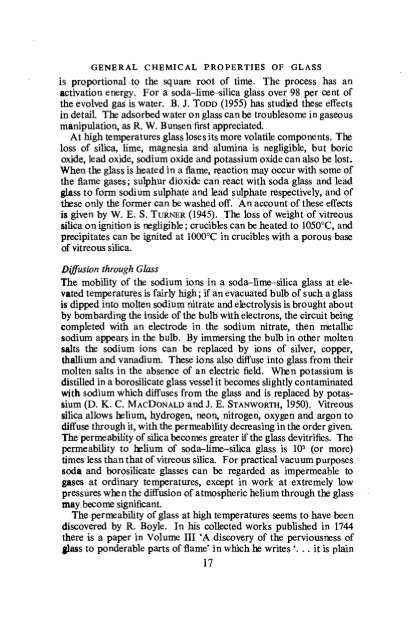Laboratory Glass-Working for Scientists - Sciencemadness Dot Org
Laboratory Glass-Working for Scientists - Sciencemadness Dot Org
Laboratory Glass-Working for Scientists - Sciencemadness Dot Org
Create successful ePaper yourself
Turn your PDF publications into a flip-book with our unique Google optimized e-Paper software.
GENERAL CHEMICAL PROPERTIES OF GLASS<br />
is proportional to the square root of time. The process has an<br />
activation energy. For a soda~lime~silica glass over 98 per cent of<br />
the evolved gas is water. B. J. TODD (1955) has studied these effects<br />
in detail. The adsorbed water on glass can be troublesome in gaseous<br />
manipulation, as R. W. Bunsen first appreciated.<br />
At high temperatures glass loses its more volatile components. The<br />
loss of silica, lime, magnesia and alumina is negligible, but boric<br />
oxide, lead oxide, sodium oxide and potassium oxide can also be lost.<br />
When the glass is heated in a flame, reaction may occur with some of<br />
the flame gases; sulphur dioxide can react with soda glass and lead<br />
glass to <strong>for</strong>m sodium sulphate and lead sulphate respectively, and of<br />
these only the <strong>for</strong>mer can be washed off. An account of these effects<br />
is given by W. E. S. TURNER (1945). The loss of weight of vitreous<br />
silica on ignition is negligible; crucibles can be heated to 1050°C, and<br />
precipitates can be ignited at 100G°C in crucibles with a porous base<br />
of vitreous silica.<br />
Diffusion through <strong>Glass</strong><br />
The mobility of the sodium ions in a soda-lime-silica glass at elevated<br />
temperatures is fairly high; if an evacuated bulb of such a glass<br />
is dipped into molten sodium nitrate and electrolysis is brought about<br />
by bombarding the inside of the bulb with electrons, the circuit being<br />
completed with an electrode in the sodium nitrate, then metallic<br />
sodium appears in the bulb. By immersing the bulb in other molten<br />
salts the sodium ions can be replaced by ions of silver, copper,<br />
thallium and vanadium. These ions also diffuse into glass from their<br />
molten salts in the absence of an electric field. When potassium is<br />
distilled in a borosilicate glass vessel it becomes slightly contaminated<br />
with sodium which diffuses from the glass and is replaced by potassium<br />
(D. K. C. MACDONALD and J. E. STANWORTH, 1950). Vitreous<br />
silica allows helium, hydrogen, neon, nitrogen, oxygen and argon to<br />
diffuse through it, with the permeability decreasing in the order given.<br />
The permeability of silica becomes greater if the glass devitrifies. The<br />
permeability to helium of soda-lime-silica glass is 10 5 (or more)<br />
times less than that of vitreous silica. For practical vacuum purposes<br />
soda and borosilicate glasses can be regarded as impermeable to<br />
gases at ordinary temperatures, except in work at extremely low<br />
pressures when the diffusion of atmospheric helium through the glass<br />
may become significant.<br />
The permeability of glass at high temperatures seems to have been<br />
discovered by R. Boyle. In his collected works published in 1744<br />
there is a paper in Volume III 'A discovery of the perviousness of<br />
glass to ponderable parts of flame' in which he writes \ .. it is plain<br />
17
















